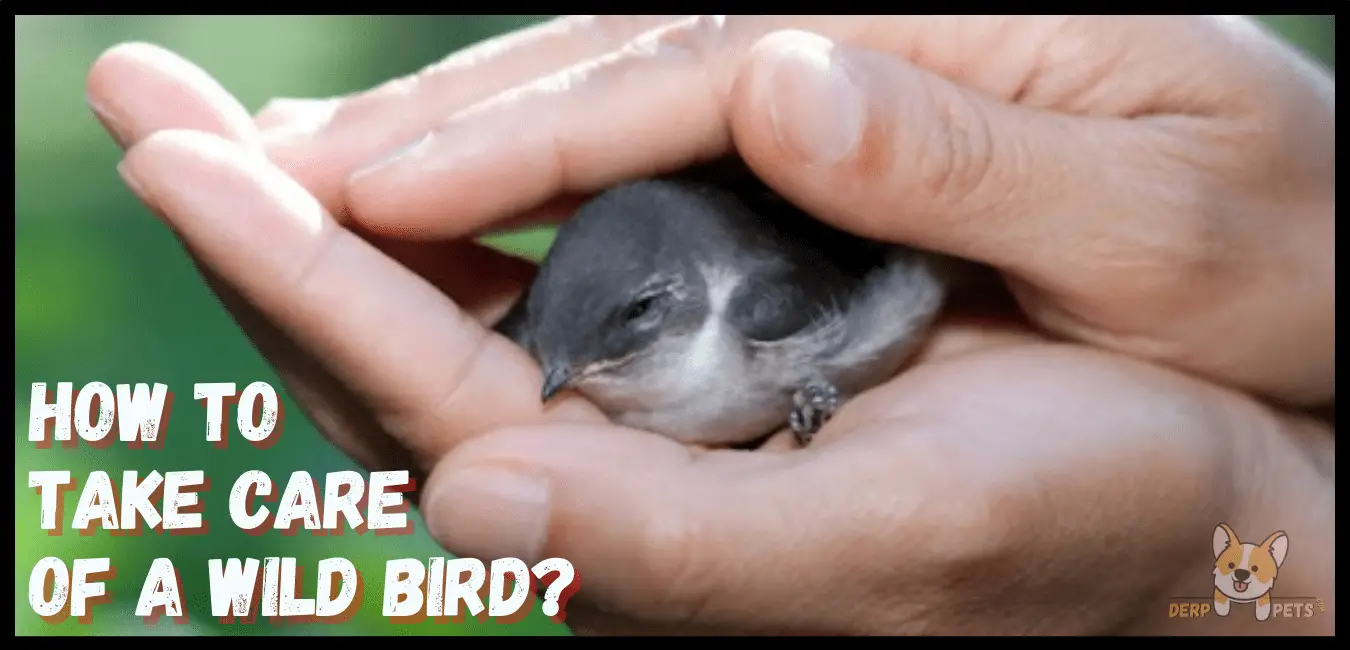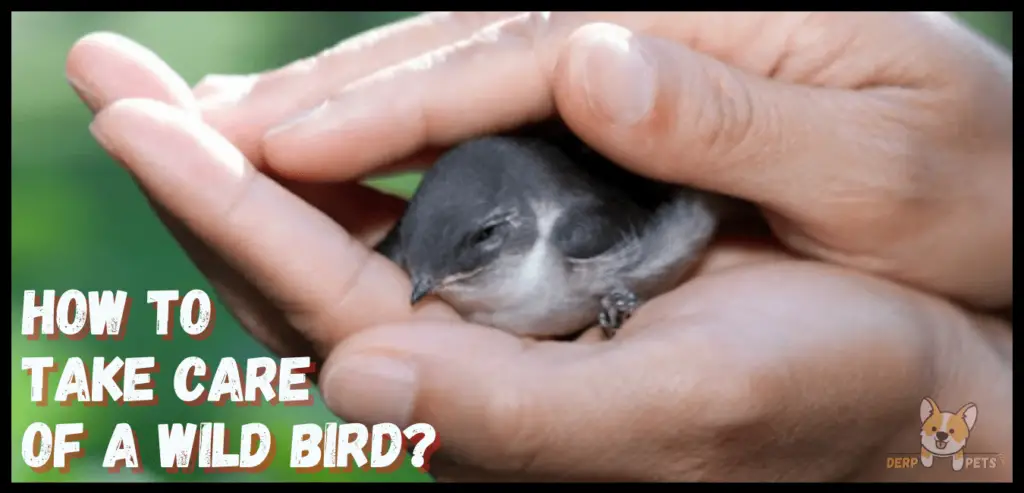
If you find an injured wild bird, then as a human being, you will definitely want to help that little winged. But if you are not a pet bird owner, then it can be a quite tough call for you because the wild birds are not the same as pet parakeet or cockatiel! With the wild bird, you have to be more careful.
So, to make it easy for you, below, I wrote a detailed guide on how to take care of a wild bird in any situation. Before you jump on that, there are three things you must know about the injured wild birds, such:
Bird species– Click a bird photo, and then search it on google. Check if it is nonlegal for you to take care of this bird species. If it is nonlegal, then quickly rescue the bird and hand it over to a nearby wild bird sanctuary or birdhouse as soon as possible.
Bird age – Check if the bird is a Hatchling – newborn bird (they need more comfort and care). Fledgling – young birds that can’t fly yet (they can recover fast when getting proper treatments). Adult/Old – mature bird (they took longer to recover if get injured poorly).
Bird size – Check if the bird is small or large! You can easily take care of a little bird when the bird is injured and in shock. Plus, due to their small size, you can easily hide them from your pets. But, large birds can be a little dangerous to manage especially, if they are wounded. Only rescue them and hand them over to a nearby vet hospital or wildlife rehabilitator.
If you are reading this article, this means you already took the injured bird in your home. So, without any delay, let’s learn how to take care of a wild bird in any circumstance.
How to take care of an Orphaned Chick/Baby Bird
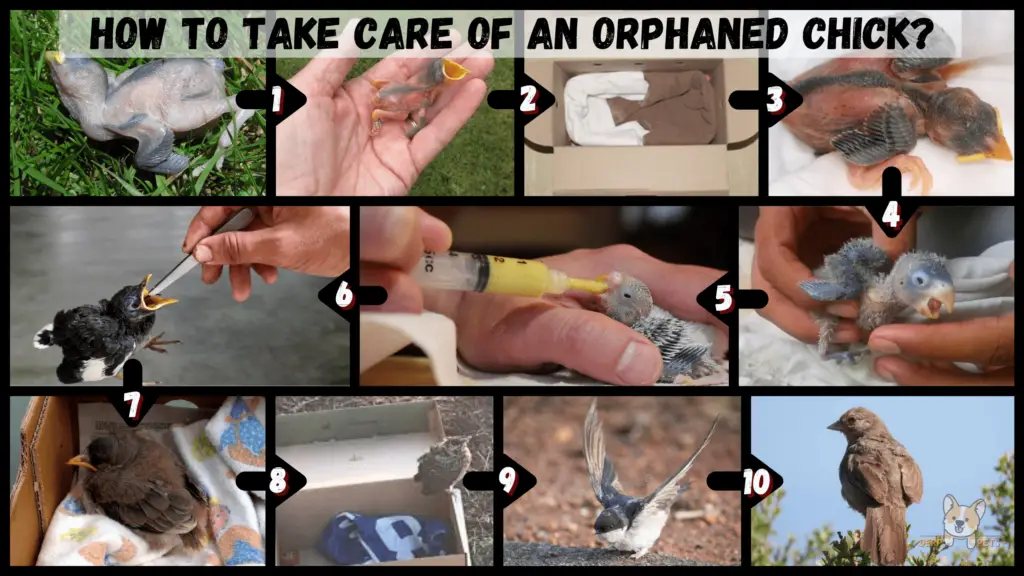
Chick can be hand-raised very effortlessly if you properly take care of them. Let’s become a parent of an orphaned chick, first prepare a safe place for the bird so the baby bird can stay warm all time. So, to do that!
- Use a sturdy cardboard box, and cut holes in its sidewalls for ventilation, not too wide, nor too small, just medium size holes.
- Now place something soft in the bottom, like cotton, towel, or any super-soft cloth.
- Always put the baby bird in a dark and quiet place. Put the bird in the box, and candidly cover the box with a cloth and make sure the box slightly opens from one side so that you can frankly check the bird at any time without disturbing the bird.
- It is time to add a heat source, effortlessly use a heating pad beneath the cardboard box throughout the day and night, and make sure the heating pad temperature is low. And if you don’t have a heating pad, then use other alternatives like a zip-top bag, bottles, stasher silicone food bag, and fill them with warm water.
- Now let the baby bird have plenty of rest! Plus, they will need your complete attention when they wake up, so make sure you stay nearby when a chick is sleeping.
- When it awake, that means the baby bird is hungry, so try to feed the baby bird with well nutrient foods liquidy or soft. Here is the best option (Kaytee Exact Hand Feeding for Baby Birds).
- For the baby bird feeding process, you’ll need syringes (check here for the best (bird feeding syringe for baby birds)! Remember, chicks will eat very often, which means every 15 to 20 minutes, even at night, so make sure you feed them properly.
- Repeat all those processes every day until they grow into fledglings.
- As they become fledgling, now they need different diets. Like, for fruit eaters: start giving them small diced fruits. For seed eaters: start giving them soaked sprout seeds. And, for insect-eaters: start giving them crickets and mealworms. Make sure you don’t kill any of these insects only to feed an orphaned baby bird. Try to find some already dead insects, which you can effortlessly find at your home and backyard corners.
- After a few days, you will see that the bird starts flapping its wings and moving around on its own. At that time, you have to take it out and let it try to fly so that the chick can become familiar with wildlife.
- Repeat these processes every day until the chick fully grows into an Adult. And that’s how you can take care of an Orphaned Baby Bird.
How to take care of an Injured Bird
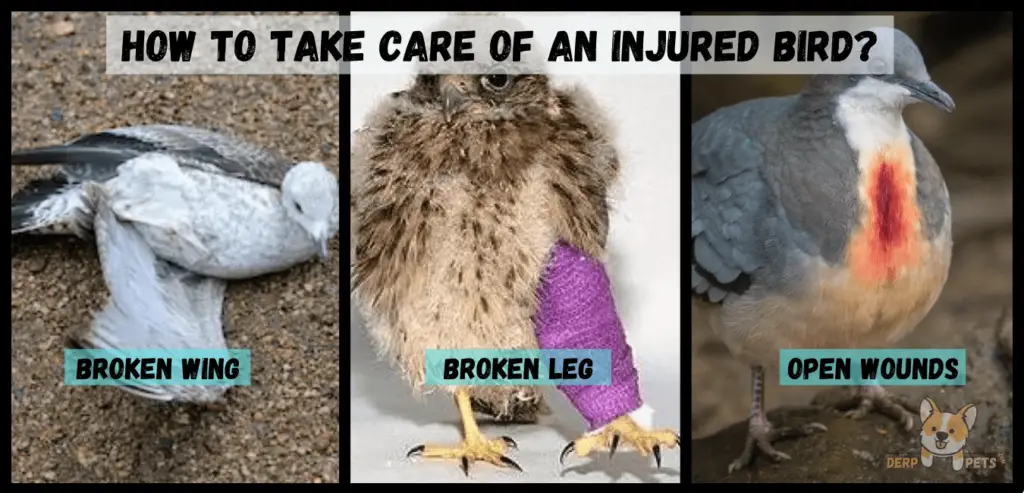
An injured wild bird can be a little tricky to handle because the bird is already frightened, and it is also an unfamiliar situation for the bird. So make sure you curb the bird very carefully.
In three circumstances, you may find an injured wild bird, like:
- Bird with broken-winged
- Bird with broken/paralyzed leg
- Bird with open wounds
Bird with broken-winged
First, try to determine the bird! Case 1, if the bird can walk but can not fly, that means you can easily take care of it. And Case 2, If the bird looks dazed, unconscious, or stunned, that means the bird, also suffering from more injuries, then wrap the bird snugly in a clean towel and take it to the nearest wildlife rescue organization or vet hospital as soon as possible.
For Case 1.
- First, wrap the bird snugly in a clean towel. Birds feel much better when wrapped up in something protective, plus it will help the bird stay calm and keep not hurting itself, so make sure you wrap the bird.
- Now let the bird rest for 5 to 10 minutes so they can feel safe.
- In that time, prepare a cardboard box for the bird with a towel and heating pad, and then put the bird in the box to keep it warm. And do not try to move the bird, except when necessary.
- Make sure you also don’t try to feed the bird with water or food too early because an injured bird will typically be too scared to eat or drink something.
- But, after some time trying to feed the bird if required, and do not force-feed, because it may end up choking the bird. Just place some food/suet and water in front of the bird, the bird will eat on-their-own.
- If the broken wing is not too bad, then the bird can surely recover within a week. After 1 or 2 days, check if the bird is alert – and even trying to get away from you – this is a good sign, so make sure you accurately observe the bird until it fully recovers.
- On the other hand, if the broken wing is too damaged to repair. Then try to take it to the vet hospital or call them as soon as possible so the veterinarians can take care of it.
Bird with broken/paralyzed leg
If you find a bird with broken legs, then it is not something that you can take care of because it may-be caused by insecticide poisoning, trauma to the head or spine, or fractures in the back, legs, or pelvis, which is not easy for people like you and me to treat it. It is better to rescue the bird as fast as you can then take it to the nearest local vet hospital.
Bird with open wounds
- That is something which we can do easily if the wound is not too big and deep. If it is big and deep as-well, then take it to the vet hospital or call them for help.
- To help the poor wounded bird first, check the bird entirely and try to stop any bleeding with cotton or a clean cloth, and at the same time apply very little pressure on the wound. Then carefully remove the cotton to ensure that bleeding has stopped.
- Now use wet cotton to clean the blood spots from the bird, and make sure you don’t hurt the bird during that process.
- Then use a box and place a towel and heating pad beneath the box. Now put the bird in the box to keep it warm and safe from your kids and pets.
- Do not feed the bird! It doesn’t need food at that moment. Let the bird take a rest for about 40 to 50 minutes or an hour. And after that, try to provide some water and food, don’t force-feed.
- And if the bird feels well after a couple of hours and seems able to fly! Then it is better to release the bird at a safe place.
Note: (If the bird is still not doing anything or just laying in the box. Then ask for help from your local veterinarians because they know how to care for a wounded bird. Tell them about the current situation of the bird, and look at what they suggest.)
How to take care of a Bird in shock
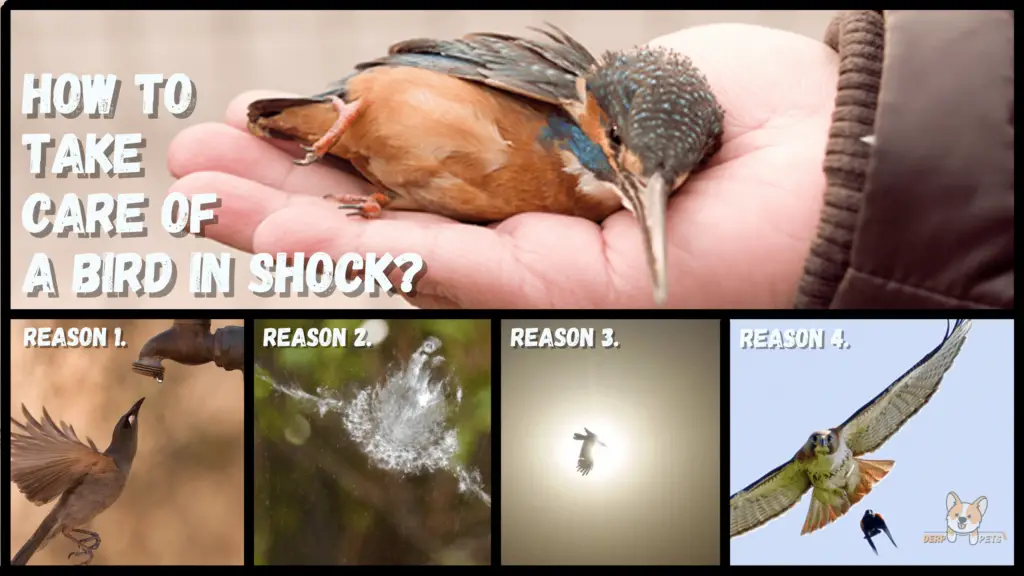
There are mainly four reasons why the bird is in shock, such as:
- Reason 1st. Due to dehydrated
- Reason 2nd. Due to hit into the window
- Reason 3rd. Due to heat stress or heat stroke
- Reason 4th. Due to heavily chased by a predator
If you don’t know if the bird is in shock or not, then observe them very closely. If the bird is in shock, then it will appear fluffed up, weak, unresponsive, and breathe in slowly and out quickly. So, to help the poor bird learn the steps below.
Case 1.
If the outside temperature is too hot that day (then probably the Reason is 1st or 3rd).
- First, move the bird to a quiet and chill place to keep it cool.
- Now mist the bird with room temperature water until the bird skin is completely wet, and make sure you use your hand for the process. Do not pour the whole water on it.
- Wait for the moment if the bird is still unconscious, then try to moist the bird’s feet and leg with cold water. Do not additionally stress the bird.
- Now repeat the process until it recovers from the shock. Generally, a small bird takes less than 2 hours, and a large bird takes around 3 to 4 hours maximum.
- Properly observe the bird, and if the bird starts breathing normally, then it is a good symbol. Most of the time, fowl shows little consciousness in between 3 to 5 minutes.
- So, if there is still no sign of recovering, then ask the nearby veterinarians for help. They will guide you if the bird has some other issues.
Case 2.
If the outside temperature is OK that day means, not too hot nor too cold (then probably the Reason is 2nd or 4th).
- First, put the bird in a cardboard box with a towel in it.
- Now place the cardboard box somewhere in a quiet, semi-dark, warm, humid environment, where the temperature should be between 25 and 30 degrees.
- Its time to add some warmness near to the bird for that, use a heating pad beneath the cardboard box to keep it warm, and if you do not have a heating pad, then try to use a water bottle filled with hot water and make sure you wrapped the bottle in a slightly damp cloth before placed near to the bird.
- While the bird is in shock, don’t force it to eat or drink. Force-feed may increase the stress level in birds. So don’t do that.
- Now let the bird take a rest for a while. And try to stay nearby the bird. Maybe it will need your help very soon, so make sure you are always there for it.
- In this situation, the bird may take around 4 to 6 hours to recover from the shock.
- If the bird does not recover in between the specified time, then take advice from the veterinarians.
How to take care of a weak or shivering bird
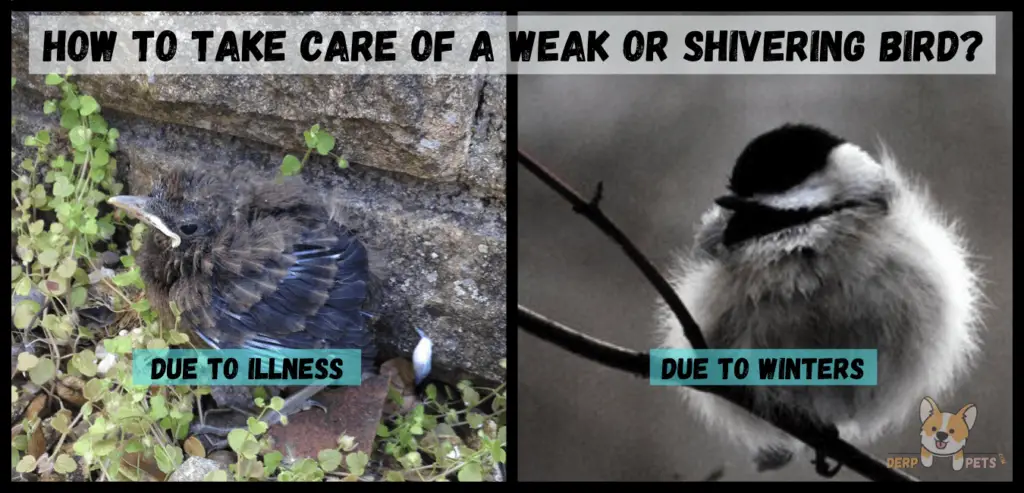
It is the most disturbing situation for birds that happens every year. Especially in winters when there is inadequate food is available for them and no place to stay warm.
In two circumstances, you may find a weak or shivering bird, known as:
- Due to illness
- Due to winters
Let’s learn how to take care of a weak or shivering bird in both situations.
Due to illness
There are so many different diseases that may cause the bird to become ill. Such as:
- Aspergillosis
- Avian pox
- Lyme Disease
- Trichomoniasis
- Feather mites
- Salmonella
- Mites and Lice
- The most important thing is that you have to determine what kind of disease the bird has. So, to determine that.
- First, rescue the bird and take it to the vet hospital so that veterinarians can examine the bird because you don’t know what kind of disease the bird actually has. Maybe the bird is in serious condition, or it is just mildly affected.
- And, if the bird is not in critical condition! So you can easily take care of that bird on your own under the instruction of the vet.
- Then, bring the bird home and place it somewhere in a warm and safe area. Most of the time, birds recover faster when kept at a warm temperature because increasing body temperature stimulates appetite, improves digestion, and stimulates the body’s defenses to fight infections.
- Now allow the bird to rest for 20 to 30 minutes before you give medicine and food. Make sure that you provide the bird all the things as recommended by the veterinarian. (Note: Ill birds need extra care and calories to fight illness and recover faster, so try to feed the bird properly with liquid foods as possible. Don’t force-feed.)
- Don’t make changes in temperature while the bird is ill because it may cause stress on birds. So, avoid changing temperatures.
- Now repeat all those processes for fast recovery.
- Accurately observe the bird and inform its current situation to the veterinarian. So, that they can make changes in medication and food if need.
- A sick bird can takes a week to recover appropriately, so be patient.
Due to winters
- First, make a warm place for it, use any box and to make the box cozy from the inside, use a towel, blanket, or whatever you have for that moment.
- Now use heating lamps, heating pads, or you can also use a bottle filled with hot water for the supplemental heat.
- After 4 to 5 minutes, check if it is still shivering or not. If not, that means the bird starts recovering, and if it is still shivering, then increase the heating pad temperature a little bit.
- As the bird is already weak, which means they need something to eat, try to feed them and make sure you only provide liquid food because the bird can not eat solid food yet due to weakness. Maybe the first time, it will reject the food, so don’t force-feed, wait for 10 to 15 minutes and then try again.
- Keep the bird in a warm place for longer, and don’t move it unless it’s necessary.
- It isn’t specified how much time does a bird takes for a full recovery? Maybe it will take hours, a day, or a week for a complete recovery.
- So, till then, make sure you properly feed the bird until the bird fully recovers. And take help from veterinarians if needed.
Advice
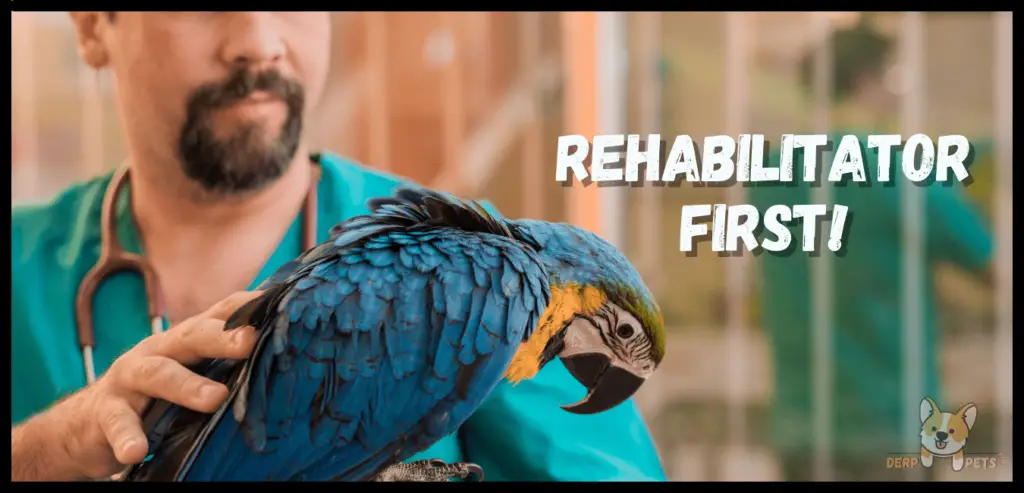
It’s always better to call a rehabilitator first in any situation! So, the chances of the bird surviving may increase by 100%. People like you and me are not absolute professional to take care of a wild bird it’s always beneficial if you take some advice from a professional veterinarian. Because these people are well trained, plus they have special equipment and skills for how to take care of a wild bird in any circumstances.
Frequently Asked Questions
Q: What to feed a wild bird that is injured?
Ans: Due to the injury, most of the time, birds don’t eat anything, so make sure you don’t force-feed. And if birds start eating or drinking, try to feed liquid food like fruit juice such as apple, pear, or grape. And also a baby bird food, which typically comes in liquid form.
Q: Can wild birds eat chia seeds?
Ans: Yes”, birds can eat chia seeds. Even chia seeds are one of the best food for birds due to the high amount of calcium and antioxidants. Chia seeds can surely fulfill the protein needs of a bird.
Q: What can you feed birds from your kitchen?
Ans: There are a dozen of things available in your kitchen that you can easily feed to a bird, such as sunflower seeds, raisins, nyjer, cooked pasta, oats, cheese, millet, boiled rice, unsalted peanuts, boiled potatoes, pumpkin seeds. And even fruits like crabapples, bananas, concord grapes, cherries, plums, elderberries, mulberries, etc.
Q: How to get a wild bird to perch on your finger?
Ans: Wild birds aren’t the same as pet birds, so it’s all about patience! Place bird’s food in your palm and stay still until the bird lands on your finger! It can take up to an hour. Once the bird lands on your finger, make sure you stay quiet as a statue.
Q: Why you shouldn’t feed birds bread?
Ans: Bread has low nutritional value, and birds need more protein and fat in their diet. So, feeding too much bread to birds is like filling their stomach with just air.

